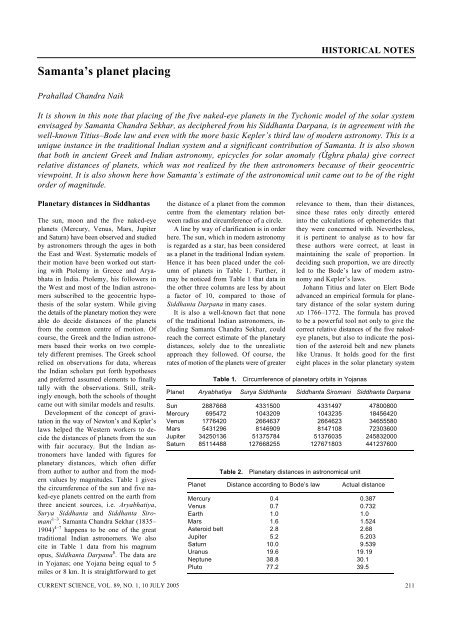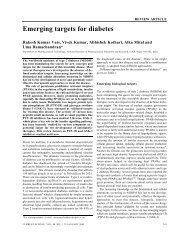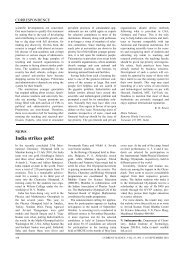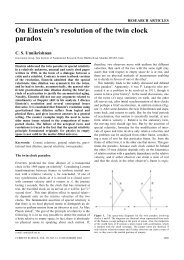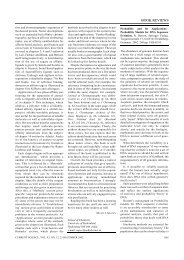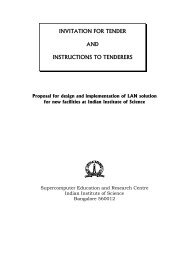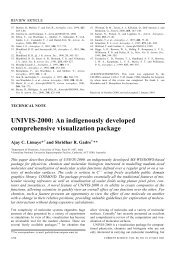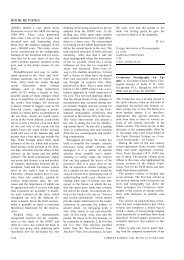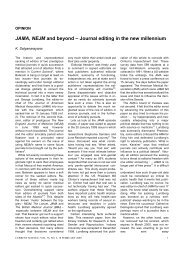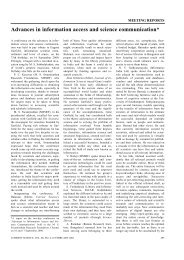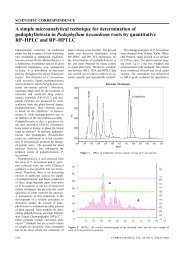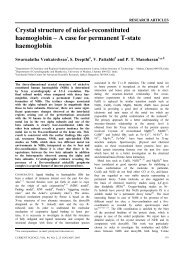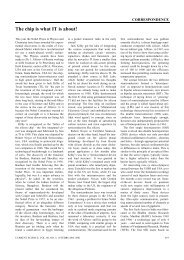Samanta's planet placing
Samanta's planet placing
Samanta's planet placing
Create successful ePaper yourself
Turn your PDF publications into a flip-book with our unique Google optimized e-Paper software.
HISTORICAL NOTES<br />
Samanta’s <strong>planet</strong> <strong>placing</strong><br />
Prahallad Chandra Naik<br />
It is shown in this note that <strong>placing</strong> of the five naked-eye <strong>planet</strong>s in the Tychonic model of the solar system<br />
envisaged by Samanta Chandra Sekhar, as deciphered from his Siddhanta Darpana, is in agreement with the<br />
well-known Titius–Bode law and even with the more basic Kepler’s third law of modern astronomy. This is a<br />
unique instance in the traditional Indian system and a significant contribution of Samanta. It is also shown<br />
that both in ancient Greek and Indian astronomy, epicycles for solar anomaly (Úîghra phala) give correct<br />
relative distances of <strong>planet</strong>s, which was not realized by the then astronomers because of their geocentric<br />
viewpoint. It is also shown here how Samanta’s estimate of the astronomical unit came out to be of the right<br />
order of magnitude.<br />
Planetary distances in Siddhantas<br />
The sun, moon and the five naked-eye<br />
<strong>planet</strong>s (Mercury, Venus, Mars, Jupiter<br />
and Saturn) have been observed and studied<br />
by astronomers through the ages in both<br />
the East and West. Systematic models of<br />
their motion have been worked out starting<br />
with Ptolemy in Greece and Aryabhata<br />
in India. Ptolemy, his followers in<br />
the West and most of the Indian astronomers<br />
subscribed to the geocentric hypothesis<br />
of the solar system. While giving<br />
the details of the <strong>planet</strong>ary motion they were<br />
able do decide distances of the <strong>planet</strong>s<br />
from the common centre of motion. Of<br />
course, the Greek and the Indian astronomers<br />
based their works on two completely<br />
different premises. The Greek school<br />
relied on observations for data, whereas<br />
the Indian scholars put forth hypotheses<br />
and preferred assumed elements to finally<br />
tally with the observations. Still, strikingly<br />
enough, both the schools of thought<br />
came out with similar models and results.<br />
Development of the concept of gravitation<br />
in the way of Newton’s and Kepler’s<br />
laws helped the Western workers to decide<br />
the distances of <strong>planet</strong>s from the sun<br />
with fair accuracy. But the Indian astronomers<br />
have landed with figures for<br />
<strong>planet</strong>ary distances, which often differ<br />
from author to author and from the modern<br />
values by magnitudes. Table 1 gives<br />
the circumference of the sun and five naked-eye<br />
<strong>planet</strong>s centred on the earth from<br />
three ancient sources, i.e. Aryabhatiya,<br />
Surya Siddhanta and Siddhanta Siromani<br />
1–3 . Samanta Chandra Sekhar (1835–<br />
1904) 4–7 happens to be one of the great<br />
traditional Indian astronomers. We also<br />
cite in Table 1 data from his magnum<br />
opus, Siddhanta Darpana 8 . The data are<br />
in Yojanas; one Yojana being equal to 5<br />
miles or 8 km. It is straightforward to get<br />
the distance of a <strong>planet</strong> from the common<br />
centre from the elementary relation between<br />
radius and circumference of a circle.<br />
A line by way of clarification is in order<br />
here. The sun, which in modern astronomy<br />
is regarded as a star, has been considered<br />
as a <strong>planet</strong> in the traditional Indian system.<br />
Hence it has been placed under the column<br />
of <strong>planet</strong>s in Table 1. Further, it<br />
may be noticed from Table 1 that data in<br />
the other three columns are less by about<br />
a factor of 10, compared to those of<br />
Siddhanta Darpana in many cases.<br />
It is also a well-known fact that none<br />
of the traditional Indian astronomers, including<br />
Samanta Chandra Sekhar, could<br />
reach the correct estimate of the <strong>planet</strong>ary<br />
distances, solely due to the unrealistic<br />
approach they followed. Of course, the<br />
rates of motion of the <strong>planet</strong>s were of greater<br />
Table 1.<br />
relevance to them, than their distances,<br />
since these rates only directly entered<br />
into the calculations of ephemerides that<br />
they were concerned with. Nevertheless,<br />
it is pertinent to analyse as to how far<br />
these authors were correct, at least in<br />
maintaining the scale of proportion. In<br />
deciding such proportion, we are directly<br />
led to the Bode’s law of modern astronomy<br />
and Kepler’s laws.<br />
Johann Titius and later on Elert Bode<br />
advanced an empirical formula for <strong>planet</strong>ary<br />
distance of the solar system during<br />
AD 1766–1772. The formula has proved<br />
to be a powerful tool not only to give the<br />
correct relative distances of the five nakedeye<br />
<strong>planet</strong>s, but also to indicate the position<br />
of the asteroid belt and new <strong>planet</strong>s<br />
like Uranus. It holds good for the first<br />
eight places in the solar <strong>planet</strong>ary system<br />
Circumference of <strong>planet</strong>ary orbits in Yojanas<br />
Planet Aryabhatiya Surya Siddhanta Siddhanta Siromani Siddhanta Darpana<br />
Sun 2887668 4331500 4331497 47800800<br />
Mercury 695472 1043209 1043235 18456420<br />
Venus 1776420 2664637 2664623 34655580<br />
Mars 5431296 8146909 8147108 72303600<br />
Jupiter 34250136 51375784 51376035 245832000<br />
Saturn 85114488 127668255 127671803 441237600<br />
Table 2.<br />
Planetary distances in astronomical unit<br />
Planet Distance according to Bode’s law Actual distance<br />
Mercury 0.4 0.387<br />
Venus 0.7 0.732<br />
Earth 1.0 1.0<br />
Mars 1.6 1.524<br />
Asteroid belt 2.8 2.68<br />
Jupiter 5.2 5.203<br />
Saturn 10.0 9.539<br />
Uranus 19.6 19.19<br />
Neptune 38.8 30.1<br />
Pluto 77.2 39.5<br />
CURRENT SCIENCE, VOL. 89, NO. 1, 10 JULY 2005 211
HISTORICAL NOTES<br />
Table 3.<br />
Ratio of <strong>planet</strong>ary distances<br />
Planet Aryabhatiya Surya Siddhanta Siddhanta Siromani Siddhanta Darpana Period in years<br />
Sun 1.00 1.00 1.00 1.00 1.00<br />
Mercury 0.24 0.24 0.24 0.3861 0.24<br />
Venus 0.615 0.615 0.6143 0.725 0.615<br />
Mars 1.88 1.88 1.88 1.5126 1.880<br />
Jupiter 11.86 11.86 11.86 5.1028 11.862<br />
Saturn 29.47 29.47 29.47 9.230 29.450<br />
Table 4.<br />
Radii of orbit of <strong>planet</strong>s<br />
Surya Siddhanta<br />
Siddhanta Darpana<br />
Even Odd Values of Western Even Odd<br />
Planet quadrant quadrant Ptolemy astronomers as in 1840s quadrant quadrant<br />
Sun 1.00 1.00 1.00 1.00 1.00 1.00<br />
Mercury 0.3694 0.3667 0.3750 0.3817 0.386 0.388<br />
Venus 0.7278 0.7222 0.7194 0.7233 0.725 0.727<br />
Mars 1.5319 1.5513 1.5190 1.5237 1.5126 1.5184<br />
Jupiter 5.1429 5.0000 5.2174 5.2028 5.1428 5.2173<br />
Saturn 9.2308 9.000 9.2308 9.5389 9.230 9.4773<br />
particularly and also fairly well in case<br />
of satellites of four major <strong>planet</strong>s, i.e. Jupiter,<br />
Saturn, Uranus and Neptune. Though<br />
initially put forth as a numerical conjecture,<br />
theoretical derivation of the law has<br />
been reported based on scale invariance<br />
and disc model 9,10 . A compact formula for<br />
the law can be given for distance of the<br />
nth <strong>planet</strong> from the sun by,<br />
r n = 0.4 + 0.3 × 2 n–2 θ(n–1),<br />
where n runs from 1 to N, starting with<br />
Mercury in the solar system, and θ(n) is<br />
the step function with property θ(n) = 1<br />
for n > 0 and zero elsewhere. One may<br />
check the validity of the law from Table<br />
2, where the actual distances of <strong>planet</strong>s<br />
and the asteroid belt from the sun are given<br />
along with those predicted by the above<br />
formula.<br />
Of course, more fundamental in this<br />
respect is Kepler’s third law, derivable<br />
from Newton’s law of gravitation, which<br />
is useful in checking <strong>planet</strong>ary distances.<br />
According to the law, r 3 ∝ T 2 , where r is<br />
the average distance of a <strong>planet</strong> from the<br />
sun and T its time period of revolution.<br />
Table 3 presents the ratio of the <strong>planet</strong>ary<br />
distances to the sun–earth distance,<br />
i.e. the astronomical unit and the ratios<br />
are expressed in the same unit as in different<br />
traditional works, including Siddhanta<br />
Darpana of Samanta Chandra Sekhar.<br />
We cite data from three prime sources,<br />
i.e. Aryabhatiya of Aryabhata 1 , and Surya<br />
Siddhanta 2 and Siddhanta Siromani of<br />
Bhaskaracharya 3 for comparison. Table 3<br />
also gives the time periods of the <strong>planet</strong>s<br />
in terrestrial year.<br />
It is easy to check that the <strong>planet</strong>ary<br />
distances derived from Siddhanta Darpana,<br />
exactly match with those computed from<br />
the power law of distance and time period.<br />
It is striking to note that the distances of<br />
<strong>planet</strong>s given by Samanta Chandra Sekhar<br />
exactly follow both Bode’s law and Kepler’s<br />
law, whereas none of the other three sources<br />
follow any of these laws, even though<br />
they give almost the same time period for<br />
the naked-eye <strong>planet</strong>s 4 . Besides, the ratios<br />
in Samanta’s data are almost close to the<br />
modern values. This is definitely an important<br />
original contribution of Chandra<br />
Sekhar.<br />
To come back to why astronomers before<br />
him did not reach the correct distances,<br />
it is worth mentioning here that<br />
they obtained the distance by assuming<br />
equal linear speed for all <strong>planet</strong>s in their<br />
respective orbits. This is not the case<br />
with Samanta’s figure, because his estimates<br />
are based on the Tychonic model, in<br />
which only the sun and moon move<br />
round the earth and other <strong>planet</strong>s move<br />
round the sun.<br />
Úîghra epicycle and <strong>planet</strong>ary<br />
distances<br />
Burgess 2 presents the radii of <strong>planet</strong>ary<br />
orbits as in Surya Siddhanta and compares<br />
them with Ptolemy’s values and<br />
those of Western astronomers in 1840s.<br />
The data seem to follow Bode’s law (Table<br />
4). The corresponding data from Siddhanta<br />
Darpana are also given in Table 4.<br />
It is to be noted that the values given<br />
here are not the linear radii of the orbits<br />
of <strong>planet</strong>s. They are the angular radii of<br />
the Úîgra epicyle (epicycle of conjunction)<br />
compared with the solar radius;<br />
when the deferent circumference is taken<br />
as 360°. For the interior <strong>planet</strong>s, one takes<br />
the ratio of the Úîghra circumference<br />
with respect to that of the deferent and<br />
for the exterior <strong>planet</strong>s, the reverse has been<br />
taken. For a simple check, we cite the<br />
Surya Siddhanta 2 and Siddhanta Darpana<br />
8 values of the circumference of the<br />
Úîghra epicycle at the ends of the even<br />
and odd quadrants separately in Table 5.<br />
This can be understood in the Tychonic<br />
model as follows.<br />
In Figure 1 a for an interior <strong>planet</strong>, E<br />
is the earth, S is the sun on a different circle<br />
and P is the <strong>planet</strong> in its orbit, which<br />
serves as the Úîghra epicycle. Thus<br />
r<br />
R = SP<br />
ES<br />
=<br />
=<br />
Radius of Úîghra epicycle<br />
Radius of the deferent<br />
Circumference of Úîghra epicycle<br />
.<br />
Circumference of deferent<br />
In Figure 1 b for an exterior <strong>planet</strong>, E is<br />
the earth, S is the sun in orbit around the<br />
earth and P is the <strong>planet</strong> in orbit around<br />
212<br />
CURRENT SCIENCE, VOL. 89, NO. 1, 10 JULY 2005
the sun, which serves as the deferent.<br />
Here the Úîghra epicycle is the reflected<br />
motion of the sun, shown as Œ. Therefore<br />
we have,<br />
r<br />
R = SP<br />
ŒP = Radius of the deferent<br />
Radius of Úîghra epicycle<br />
Circumference of deferent<br />
=<br />
Circumference of Úîghra epicycle .<br />
Earlier astronomers could not realize this<br />
on account of their geocentric view.<br />
Samanta’s estimate of<br />
astronomical unit<br />
a<br />
From Table 1, we see that Samanta’s<br />
value of the astronomical unit comes out<br />
to be 4.78 × 10 7 × 8/2π km = 6.09 × 10 7 km.<br />
This is of the right order of magnitude<br />
and only 4/10 of the true value of 14.96 ×<br />
10 7 km. It is worth presenting therefore,<br />
how Samanta arrived at this figure. It has<br />
been elaborately described by Ray 4 .<br />
It was in the context of calculation of<br />
eclipses where the horizontal parallaxes<br />
of the sun and moon enter and their numerical<br />
figures matter in the prediction<br />
of these events. But like all earlier traditional<br />
astronomers, Samanta did not know<br />
how to determine the distance of the sun.<br />
Ray narrates how Chandra Sekhar found<br />
a way to do so. The account reads, ‘One<br />
day, thus dejected in mind, while he was<br />
coming home, he noticed an image of the<br />
sun, projected through a narrow aperture<br />
in a fence of palm leaves close to his house’.<br />
This gave Samanta the idea of estimating<br />
the sun’s distance, only if its linear diameter<br />
was known. But he was sure that it<br />
was not correctly known either; sources<br />
differed with their data.<br />
Ray continues ‘These questions were<br />
not out of his mind for a single day through<br />
a long year’. While reading the Atharvan<br />
Upanishad, he was surprised to find that<br />
the sun’s diameter was not 6500 Yojanas<br />
as given in the Surya Siddhanta, but<br />
72000 Yojanas. And this led him to decide<br />
the distance using accurate estimate<br />
of the angular diameter and also, may be,<br />
independently by projection through the<br />
aperture.<br />
Besides, Samanta specifically mentions<br />
at least in two places in Siddhanta Darpana,<br />
regarding the diameter of the Sun.<br />
b<br />
HISTORICAL NOTES<br />
(Siddhanta Darpana Ch. 8, Sloka-12)<br />
(72000 Yojanas is the spherical diameter<br />
of the sun, as per Seers’ words in the<br />
Atharva Veda. In accordance with that I<br />
deduce without any flaw, the visual diameters<br />
of the asterisms and <strong>planet</strong>s, their<br />
circumference and eclipses, etc. to agree<br />
with observation.)<br />
(Siddhanta Darpana Ch. 19, Sloka-48-50)<br />
(The Vedic words cannot be overridden<br />
by hypothesis. Therefore, I have accepted<br />
the diameter of the sun given in the Vedas.<br />
While explaining the implication of ‘pranava’,<br />
the Brahmavidyopanishad gives<br />
the diameter of the sun to be 72000 Yojanas.<br />
This measure given by the great seers is<br />
true to observation, and also true is the<br />
diameter of the earth given by Surya<br />
siddhanta.)<br />
In these slokas, the author emphatically<br />
says that the figure taken from the<br />
Brahmopanishad of Atharva Veda, is<br />
also ‘ ’ (true by observation). This is<br />
because the value of parallax thus arrived<br />
used in the prediction of eclipses definitely<br />
agreed with his observations.<br />
We have further traced the clue into the<br />
original source, Brahmavidyopanishad15.<br />
In this scripture, with the starting verses<br />
is given the annotation of pranava, i.e.<br />
Omkar. We quote the relevant lines only.<br />
Figure 1. Úîghra epicycle for (a) inner <strong>planet</strong> and (b) outer <strong>planet</strong>.<br />
Table 5.<br />
Circumference of Úîghra epicycle of <strong>planet</strong>s in degrees<br />
Surya Siddhanta<br />
Siddhanta Darpana<br />
Planet Even quadrant Odd quadrant Even quadrant Odd quadrant<br />
Sun 360 360 360 360<br />
Mercury 133 132 139 140<br />
Venus 262 260 261 262<br />
Mars 235 232 238 237<br />
Jupiter 70 72 70 69<br />
Saturn 39 40 39 38<br />
CURRENT SCIENCE, VOL. 89, NO. 1, 10 JULY 2005 213
HISTORICAL NOTES<br />
(On the solar sphere there lies the a-kar<br />
( ) inside a conch. The u-kar ( )<br />
exists inside that like the moon. The ma-kar<br />
( ) resembles the fire, blazing and<br />
dazzling. The three matras ( ), i.e.<br />
components are to be visualized as sun,<br />
moon and fire. The flame rises as lamp,<br />
above that; and that is visualized as the<br />
ardha-matra (half component) above the<br />
pranava (i.e. om-kar). That flame appears as<br />
fine as lotus fibre and measures a nadi. It<br />
is as bright as the sun; and enters deep<br />
inside seventy two thousand nadis is the<br />
measure through to the top. That (pranava)<br />
is all pervading and bestows benedictions<br />
to the material world.<br />
It is definitely an interesting picture of<br />
‘Omkar’ structure compared with the<br />
visual image of the sun, i.e. with the photosphere<br />
and the outer flame. The half<br />
mâtra ‘chandrabindu’ is visualized as the<br />
flame with the dimension of a nâdî;<br />
whereas the solar disc from bottom to the<br />
terminal is 72000 nâdîs. Samanta has<br />
definitely taken the figure from here. But<br />
there surfaces a problem of units. Nâdî in<br />
the traditional Indian system is a unit of<br />
time, which is 1/60th of a solar day. But<br />
here a nâdî is no doubt taken as a measure<br />
of length. Samanta has reckoned a nâdî<br />
as a Yojana, although we find no such<br />
mention in ancient literature.<br />
Once the linear diameter is fixed, it is<br />
easy to arrive at the distance either by the<br />
aperture projection, for which the formula<br />
is given in sloka 62–64, Ch. 19 of Siddhanta<br />
Darpana; or directly from the angular<br />
diameter of the sun, which Samanta<br />
decides to be 32′32″06″′. It is equal to<br />
72000/2213, as given by Samanta in<br />
sloka-15, Ch. 08. The figure in the denominator,<br />
i.e. 2213 comes out of the relation,<br />
θ′ = 72000 180 × 60<br />
×<br />
7608294 π<br />
72000<br />
=<br />
7608294/(180 × 60)/π = 72000<br />
2213 .<br />
The distance of the sun is given as 7608294<br />
Yojanas and θ′ is the angular diameter in<br />
min.<br />
Conversely,<br />
d =<br />
72000 × 10800<br />
.<br />
θ ′ × π<br />
The accuracy up to which the angular diameter<br />
has been given could not have<br />
been attained by measurement, with the<br />
instruments Samanta was using for the<br />
purpose. Probably, with the assumed linear<br />
diameter of 72000 Yojanas for the sun,<br />
he has determined the distance by the<br />
method of projection through the aperture.<br />
1. Aryabhata, Aryabhatiya, Critical edition<br />
by K. S. Shukla and K. V. Sarma, Indian<br />
National Science Academy, New Delhi,<br />
1976, p. 101.<br />
2. Surya Siddhanta, English translation and<br />
notes by E. Burgess (ed. Gangooly, P.),<br />
Indological Book House, New Delhi,<br />
1977, p. 295.<br />
3. Bhaskaracharya, Siddhanta Siromani,<br />
English exposition and annotation by D.<br />
Arkasomayaji, Kendriya Sanskrit Vidyapeetha,<br />
Tirupati, 1980, p. 50.<br />
4. Roy, J. C., Introduction to Siddhanta<br />
Darpana, Samanta Chandra Sekhar, Indian<br />
Depository, Calcutta, 1899.<br />
5. W. R. P., Nature, 1899, 59, 436–437.<br />
6. Naik, P. C. and Satpathy, L., Curr. Sci.,<br />
1995, 69, 705.<br />
7. Naik, P. C. and Satpathy, L., Bull.<br />
Astron. Soc. India, 1998, 36, 33–49.<br />
8. Samanta Chandra Sekhar, Siddhanta<br />
Darpana, Oriya translation by Bira Hanuman<br />
Sastri, Utkal University, 1976, p.<br />
432.<br />
9. Graner, F. and Dubralle, B., Astron. Astrophys.,<br />
1994, 282, 262–288.<br />
10. Dubralle, B. and Graner, F., Astron. Astrophys.,<br />
1994, 282, 269–276.<br />
11. Pandit Jagadish Shashtri, Upanishatsamgraha,<br />
Motilal Banarasidass Publishers,<br />
1970, (1998–Reprint), p. 292.<br />
ACKNOWLEDGEMENT. I thank Sri S. K.<br />
Vidyalankar, Department of Sanskrit, Dharanidhar<br />
Autonomous College, Keonjhar, for<br />
help in tracing the clue on diameter of the sun<br />
in Brahmavidyopanishad.<br />
Prahallad Chandra Naik is in the Department<br />
of Physics, Dharanidhar Autonomous<br />
College, Keonjhar 758 001, India.<br />
e-mail: prahalladchandra@yahoo.com<br />
Edited and published by P. Balaram, Current Science Association, Bangalore 560 080.<br />
Typeset by WINTECS Typesetters (Ph: 2332 7311), Bangalore 560 021 and Printed at Lotus Printers, Bangalore (Ph: 2320 9909)<br />
214<br />
CURRENT SCIENCE, VOL. 89, NO. 1, 10 JULY 2005


